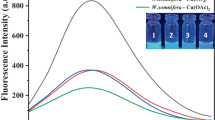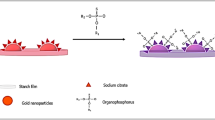Abstract
In this paper, a new synthetic route is introduced for the synthesis of high-luminescent greenish-yellow fluorescent copper nanoclusters (PVP@A. senna-Cu NCs) using Avaram senna (A. senna) and polyvinylpyrrolidone (PVP) as templates. A. senna plant extract mainly contains variety of phytochemicals including glycosides, sugars, saponins, phenols, and terpenoids that show good pharmacological activities such as anti-inflammatory, antioxidant, and antidiabetic. PVP is a stable and biocompatible polymer that is used as a stabilizing agent for the synthesis of PVP@A. senna-Cu NCs. The size, surface functionality, and element composition of the fabricated Cu NCs were confirmed by various analytical techniques. The as-prepared greenish-yellow fluorescent Cu NCs exhibit significant selectivity towards fipronil, thereby favoring to assay fipronil pesticide with good linearity in the range of 3.0–30 μM with a detection limit of 65.19 nM. More importantly, PVP@A. senna-Cu NCs are successfully applied to assay fipronil in vegetable and grain samples.






Similar content being viewed by others
Availability of Data and Materials
Data will be available from corresponding author on demand.
References
Wang X, Martinez MA, Wu Q, Ares I, Martínez-Larrañaga MR, Anadón A, Yuan Z (2016) Fipronil insecticide toxicology: Oxidative stress and metabolism. Crit Rev Toxicol 46:876–899. https://doi.org/10.1080/10408444.2016.1223014
Guo Q, Zhao S, Zhang J, Qi K, Du Z, Shao B (2018) Determination of fipronil and its metabolites in chicken egg, muscle and cake by a modified QuEChERS method coupled with LC-MS/MS. Food Addit Contam Part A 35:1543–1552. https://doi.org/10.1080/19440049.2018.1472395
Lopez-Antia A, Ortiz-Santaliestra ME, Camarero PR, Mougeot F, Mateo R (2015) Assessing the risk of fipronil-treated seed ingestion and associated adverse effects in the red-legged partridge. Environ Sci Technol 49:13649–13657. https://doi.org/10.1021/acs.est.5b03822
Bhatt P, Gangola S, Ramola S, Bilal M, Bhatt K, Huang Y, Zhou Z, Chen S (2023) Insights into the toxicity and biodegradation of fipronil in contaminated environment. Microbiol Res 266:127247. https://doi.org/10.1016/j.micres.2022.127247
Zhang M, Bian K, Zhou T, Song X, Liu Q, Meng C, He L (2016) Determination of residual fipronil in chicken egg and muscle by LC-MS/MS. J Chromatogr B Analyt Technol Biomed Life Sci 1014:31–36. https://doi.org/10.1016/j.jchromb.2016.01.041
Kim TY, Lim JW, Lim MC, Song NE, Woo MA (2020) Aptamer-based fluorescent assay for simple and sensitive detection of fipronil in liquid eggs. Biotechnol Bioprocess Eng 25:246–254. https://doi.org/10.1007/s12257-019-0358-1
Ly NH, Nguyen TH, Nghi NĐ, Kim YH, Joo SW (2019) Surface-enhanced raman scattering detection of fipronil pesticide adsorbed on silver nanoparticles. Sensors 19:1355. https://doi.org/10.3390/s19061355
Wang K, Vasylieva N, Wan D, Eads DA, Yang J, Tretten T, Barnych B, Li J, Li QX, Gee SJ, Hammock BD, Xu T (2019) Quantitative detection of fipronil and fipronil-sulfone in sera of black-tailed prairie dogs and rats after oral exposure to fipronil by camel single-domain antibody-based immunoassays. Anal Chem 91:1532–1540. https://doi.org/10.1021/acs.analchem.8b04653
Nurdin M, Prabowo OA, Arham Z, Wibowoc D, Maulidiyah M, Saad SKM, Umar AA (2019) Highly sensitive fipronil pesticide detection on ilmenite (FeO.TiO2)-carbon paste composite electrode. Surf Interfaces 16:108–113. https://doi.org/10.1016/j.surfin.2019.05.008
Kang X, Zhu M (2019) Tailoring the photoluminescence of atomically precise nanoclusters. Chem Soc Rev 48:2422–2457. https://doi.org/10.1039/C8CS00800K
Kailasa SK, Borse S, Koduru JR, Murthy ZVP (2021) Biomolecules as promising ligands in the synthesis of metal nanoclusters: Sensing, bioimaging and catalytic applications. Trends in Environ Anal Chem 32:e00140. https://doi.org/10.1016/j.teac.2021.e00140
Chakraborty I, Pradeep T (2017) Atomically precise clusters of noble metals: emerging link between atoms and nanoparticles. Chem Rev 117:8208–8271. https://doi.org/10.1021/acs.chemrev.6b00769
Yao Q, Chen T, Yuan X, **e J (2018) Toward total synthesis of thiolate-protected metal nanoclusters. Acc Chem Res 51:1338–1348. https://doi.org/10.1021/acs.accounts.8b00065
Liu JW, Feng L, Su HF, Wang Z, Zhao QQ, Wang XP, Tung CH, Sun D, Zheng LS (2018) Anisotropic assembly of Ag52 and Ag76 nanoclusters. J Am Chem Soc 140:1600–1603. https://doi.org/10.1021/jacs.7b12777
Desireddy A, Conn BE, Guo J, Yoon B, Barnett RN, Monahan BM, Kirschbaum K, Griffith WP, Whetten RL, Landman U, Bigioni TP (2013) Ultrastable silver nanoparticles. Nature 501:399–402. https://doi.org/10.1038/nature12523
Qian S, Wang Z, Zuo Z, Wang X, Wang Q, Yuan X (2022) Engineering luminescent metal nanoclusters for sensing applications. Coord Chem Rev 451:214268. https://doi.org/10.1016/j.ccr.2021.214268
Shang L, Xu J, Nienhaus GU (2019) Recent advances in synthesizing metal nanocluster-based nanocomposites for application in sensing, imaging and catalysis. Nano Today 28(2019):100767. https://doi.org/10.1016/j.nantod.2019.100767
**ao Y, Wu Z, Yao Q, **e J (2021) Luminescent metal nanoclusters: Biosensing strategies and bioimaging applications. Aggregate 2:114–132. https://doi.org/10.1002/agt2.11
Yuan X, Luo Z, Yu Y, Yao Q, **e J (2013) Luminescent noble metal nanoclusters as an emerging optical probe for sensor development. Chem-Asian J 8:858–871. https://doi.org/10.1002/asia.201201236
Chen YA, Obliosca JM, Liu YL, Liu C, Gwozdz ML, Yeh HC (2015) Nanocluster beacons enable detection of a single N(6)-methyladenine. J Am Chem Soc 137:10476–10479. https://doi.org/10.1021/jacs.5b06038
Borse S, Murthy ZVP, Kailasa SK (2020) Chicken egg white mediated synthesis of platinum nanoclusters for the selective detection of carbidopa. Opt Mater 107:110085. https://doi.org/10.1016/j.optmat.2020.110085
Desai ML, Basu H, Saha S, Singhal RK, Kailasa SK (2021) Fluorescence enhancement of bovine serum albumin gold nanoclusters from La3+ ion: Detection of four divalent metal ions (Hg2+, Cu2+, Pb2+ and Cd2+). J Mol Liq 336:116239. https://doi.org/10.1016/j.molliq.2021.116239
Xue R, Geng X, Liang F, Liu Y, Yang W, Huang Z (2022) Natural plant compounds in synthesis and luminescence modulation of metal nanoclusters: Toward sustainable nanoprobes for sensing and bioimaging. Mater Today Adv 16:100279. https://doi.org/10.1016/j.mtadv.2022.100279
Aires A, Llarena I, Moller M, Smirnov JC, Gonzalez JC, Cortajarena AL (2019) A simple approach to design proteins for the sustainable synthesis of metal nanoclusters. Angew Chem Int Ed Engl 58:6214–6219. https://doi.org/10.1002/anie.201813576
Maity S, Bain D, Chakraborty S, Kolay S, Patra A (2020) Copper nanocluster (Cu23 NC)-based biomimetic system with peroxidase activity. ACS Sustainable Chem Eng 8:18335–18344. https://doi.org/10.1021/acssuschemeng.0c07431
Borse S, Jha S, Murthy ZVP, Kailasa SK (2022) Sustainable chemistry approach for the preparation of bluish green emissive copper nanoclusters from Justicia adhatoda leaves extract: a facile analytical approach for the sensing of myoglobin and L-thyroxine. New J Chem 46:15919. https://doi.org/10.1039/D2NJ02524H
Bhamore JR, Deshmukh B, Haran V, Jha S, Singhal RK, Lenka N, Kailasa SK, Murthy ZVP (2018) One-step eco-friendly approach for the fabrication of synergistically engineered fluorescent copper nanoclusters: sensing of Hg2+ ion and cellular uptake and bioimaging properties. New J Chem 42:1510. https://doi.org/10.1039/C7NJ04031H
Desai ML, Basu H, Saha S, Singhal RK, Kailasa SK (2020) One pot synthesis of fluorescent gold nanoclusters from Curcuma longa extract for independent detection of Cd2+, Zn2+ and Cu2+ ions with high sensitivity. J Mol Liq 304:112697. https://doi.org/10.1016/j.molliq.2020.112697
** L, Zhang Z, Tang A, Li C, Shen Y (2016) Synthesis of yeast extract-stabilized Cu nanoclusters for sensitive fluorescent detection of sulfide ions in water. Biosens Bioelectron 79:108–113. https://doi.org/10.1016/j.bios.2015.12.001
Saleh SM, Almotiri MK, Ali R (2022) Green synthesis of highly luminescent gold nanoclusters and their application in sensing Cu(II) and Hg(II). J Photochem Photobiol 426:113719. https://doi.org/10.1016/j.jphotochem.2021.113719
Joshi DJ, Lalrinhlupuii MNI, Muthukumaran RB, Kailasa SK (2022) Microwave-assisted synthesis of red emitting copper nanoclusters using trypsin as a ligand for sensing of Pb2+ and Hg2+ ions in water and tobacco samples. Appl Spectrosc 76:1234–1245. https://doi.org/10.1177/00037028221100544
Saleh SM, El-Sayed WA, El-Manawaty MA, Gassoumi M, Ali R (2022) An eco-friendly synthetic approach for copper nanoclusters and their potential in lead ions sensing and biological applications. Biosensors 12:197. https://doi.org/10.3390/bios12040197
Sebastian A, Aarya SBR, Mojumdar SS (2023) Lysozyme protected copper nano-cluster: A photo-switch for the selective sensing of Fe2+. J Photochem Photobiol A Chem 436:1–9. https://doi.org/10.1016/j.jphotochem.2022.114378
Bu X, Fu Y, ** H, Gui R (2018) Specific enzymatic synthesis of 2,3-diaminophenazine and copper nanoclusters used for dual-emission ratiometric and naked-eye visual fluorescence sensing of choline. New J Chem 42:17323–17330. https://doi.org/10.1039/C8NJ03927E
Miao Z, Hou W, Liu M, Zhang Y, Yao S (2018) BSA capped bi-functional fluorescent Cu nanoclusters as pH sensor and selective detection of dopamine. New J Chem 42:1446–1456. https://doi.org/10.1039/C7NJ03524A
Jayasree M, Aparna RS, Anjana RR, Anjali Devi JS, John N, Abha K, Manikandan A, George S (2018) Fluorescence turn on detection of bilirubin using Fe (III) modulated BSA stabilized copper nanocluster; A mechanistic perception. Anal Chim Acta 1031:152–160. https://doi.org/10.1016/j.aca.2018.05.026
**aoqing L, Ruiyi L, **aohuan L, Zaijun L (2015) Ultra sensitive and wide-range pH sensor based on the BSA-capped Cu nanoclusters fabricated by fast synthesis through the use of hydrogen peroxide additive. RSC Adv 5:48835–48841. https://doi.org/10.1039/C5RA07966G
Lai WF, Wong WT, Rogach AL (2020) Development of copper nanoclusters for in vitro and in vivo theranostic applications. Adv Mater 32:1906872. https://doi.org/10.1002/adma.201906872
Maity S, Bain D, Patra A (2019) Engineering atomically precise copper nanoclusters with aggregation induced emission. J Phys Chem C 123:2506–2515. https://doi.org/10.1021/acs.jpcc.8b09467
Baghdasaryan A, Bürgi T (2021) Copper nanoclusters: designed synthesis, structural diversity, and multiplatform applications. Nanoscale 13:6283. https://doi.org/10.1039/D0NR08489A
Li Y, Feng L, Yan W, Hussain I, Su L, Tan B (2019) PVP-templated highly luminescent copper nanoclusters for sensing trinitrophenol and living cell imaging. Nanoscale 11:1286–1294. https://doi.org/10.1039/C8NR07142J
Surana SJ, Gokhale SB, Jadhav RB, Sawant RL, Wadekar JB (2008) Antihyperglycemic activity of various fractions of Cassia auriculata Linn: in Alloxan diabetic rats. Indian J Pharm Sci 70:227–229. https://doi.org/10.4103/0250-474X.41461
Nille GC, Mishra SK, Chaudhary AK, Reddy KRC (2021) Ethnopharmacological, phytochemical, pharmacological, and toxicological review on senna auriculata (l.) roxb.: a special insight to antidiabetic property. Front Pharmacol 12:647887. https://doi.org/10.3389/fphar.2021.647887
Jaydeokar AV, Bandawane DD, Bibave KH, Patil TV (2014) Hepatoprotective potential of Cassia auriculata roots on ethanol andante tubercular drug-induced hepatotoxicity in experimental models. Pharm Biol 52:344–355. https://doi.org/10.3109/13880209.2013.837075
Vadia FY, Ghosh S, Mehta VN, Jha S, Malek NI, Park TJ, Kailasa SK (2023) Fluorescence “Turn OFF-ON” detection of Fe3+ and propiconazole pesticide using blue emissive carbon dots from lemon peel. Food Chem 428:136796. https://doi.org/10.1016/j.foodchem.2023.136796
Maruthupandia M, Thiruppathib D, Vasimalai N (2020) One minute synthesis of green fluorescent copper nanocluster: The preparation of smartphone aided paper-based kit for on-site monitoring of nanomolar level mercury and sulfide ions in environmental samples. J Hazard Mater 392:122294. https://doi.org/10.1016/j.jhazmat.2020.122294
Pandit S, Kundu S (2020) pH-Dependent reversible emission behaviour of lysozyme coated fluorescent copper nanoclusters. J Lumin 228:117607. https://doi.org/10.1016/j.jlumin.2020.117607
Bhamore JR, Ganguly P, Kailasa SK (2016) Molecular assembly of 3-mercaptopropinonic acid and guanidineacetic acid on silver nanoparticles for selective colorimetric detection of triazophos in water and food samples. Sens Actuators B Chem 233:486–495. https://doi.org/10.1016/j.snb.2016.04.111
Acknowledgements
NVG thanks the Director, SVNIT, Surat for providing doctoral fellowship and infrastructural facilities to perform this work. This work was financially supported by Gujarat State Biotechnology Mission (GSBTM), DST, Govt. of Gujarat, India (BR-04 (GSBTM/JD(R&D)662/2022-23/00292169).
Funding
Financial support form the Gujarat State Biotechnology Mission (GSBTM), DST, Govt. of Gujarat, India (BR-04 (GSBTM/JD(R&D)662/2022–23/00292169) and SVNIT, Surat, India.
Author information
Authors and Affiliations
Contributions
Nirav Vajubhai Ghinaiya: Conceptualization, Methodology, Formal analysis, Data curation, Writing – original draft. Vaibhavkumar N .Mehta: Methodology, Formal analysis, Data curation. Sanjay Jha: Investigation, Validation, Data curation. Tae Jung Park: Investigation, Validation, Data curation. Suresh Kumar Kailasa: Resources, Supervision, Project administration, Funding acquisition.
Corresponding author
Ethics declarations
Ethical Approval
There are no ethical approvals required for this research work.
Consent for Publication
Not Applicable.
Competing Interests
The authors declare no competing interests.
Additional information
Publisher's Note
Springer Nature remains neutral with regard to jurisdictional claims in published maps and institutional affiliations.
Supplementary Information
Below is the link to the electronic supplementary material.
Rights and permissions
Springer Nature or its licensor (e.g. a society or other partner) holds exclusive rights to this article under a publishing agreement with the author(s) or other rightsholder(s); author self-archiving of the accepted manuscript version of this article is solely governed by the terms of such publishing agreement and applicable law.
About this article
Cite this article
Ghinaiya, N.V., Mehta, V.N., Jha, S. et al. Synthesis of Greenish-Yellow Fluorescent Copper Nanocluster for the Selective and Sensitive Detection of Fipronil Pesticide in Vegetables and Grain Samples. J Fluoresc (2023). https://doi.org/10.1007/s10895-023-03464-0
Received:
Accepted:
Published:
DOI: https://doi.org/10.1007/s10895-023-03464-0




